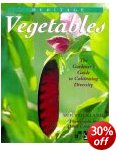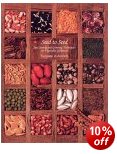Gardeners manage plant continuity by
gardening seed.
'for seed suppliers then click here for my flower seed page.
You can save seed from cultivated plants or wild flowers and trees. But collecting and saving seed for sowing has some limitations and may involve special pre-germination techniques as described below.
Cultivated plants chosen for seed propagation must of course flower and produce viable seed. Some flowering plants are in fact sterile.
Cultivated flowers, fruit and vegetables grown by gardeners from saved seed, include tomatoes, peppers, melons, cucumbers, beans, sprouts, carrots etc ... However, plants grown by gardening seed from F1 hybrids will not come true to type and the results are unpredictable. Also, if you have different varieties growing anywhere nearby there's a good chance of cross pollination and some unexpected variation. Tomatoes, being self-pollinated, are not as susceptible but best harvested end of season.
Fruit should be well-ripe when picked and usually past the eating stage. Cucumbers will be soft and yellow while egg plant will be hard and discoloured. Saved seed is normally taken from fruit at the end of the harvest. Seeds of peppers, and melons can be taken when fruit are ripe to eat. Seed should be cleaned, dried and stored air-tight and cool. I put them in labelled envelopes in a screw top glass jar.
Note that biennials like root crops are left for a 2nd year to flower and seed. Choose one or two plants to leave. But you can grow a different main crop in that year. By gardening seed you have the opportunity to reproduce plants that are best suited to your garden and taste. But this requires some organisation and diligence.
Note that soft fruit bushes and ornamentals grafted onto rootstocks (e.g. container grown cherries) will not have the same shape when grown by gardening seed.
In the garden foxglove, poppies, mullien, primula, various alpines, poached-egg plant Limnanthes douglasii, marigolds, sunflower, are just some of the plants that may be conveniently saved for the flower garden.
Seed saving from wild flowers is useful for making your own wild flower habitat and it is sometimes used to conserve wild species and heritage varieties. Take care to harvest only part of the wild population, and then not every year. By gardening seed, the range of rarer species like the Turkey Oak have been extended and woodlands created in new areas.
Seed preparation usually requires 4 stages: seed collection, seed cleaning, either storing or pre-germination, then germination.Collect ripe fruit and seed.Nuts such as beech mast, edible chestnut and acorns can be picked off the ground. Each nut contains one seed but Horse chestnut (conkers) is itself a large seed.
Non-splitting fruit of berries, apples and the like are cleaned by washing to separate the soft pulp from the seed. This removes natural chemicals that may inhibit germination. Several factors can delay germination.
Dormancy: The seed embryo needs to be released from dormancy. In many tree seeds, dormancy breaks after exposure to a cold period. The cold pre-germination treatment is called stratification. The seed is layered (stratified) in moist sand or on tissue paper inside a fridge between 1oC and 5oC.
Resistant seed coat: The thickness of the seed coat may prevent water adsorption. Scarification treatments aim to break down the seed coat. They include chemical treatments with acid, or abrasive treatments with sand or by filing down the seed coat.
Some plants germinate well after exposure to fire.
Pre-germination - Stratification Treatments
|
|
Common Name |
Botanic Name
|
Cold Treatment
|
| Rowan | Sorbus | 90 – 120 days
|
|
| Contoneaster | 90 – 120 days
|
|
Rose | Rosa | 90 – 120 days
|
|
| Davidia | 90 – 120 days
|
|
Oak | Quercus | |
|
Sweet Chestnut | Aesculus | |
|
Maple | Acer |
30 – 60 days
|
|
Birch | Betula | 30 – 60 days
|
Dry splitting fruit such as pods, capsules etc… are picked into a bag. Allow the seed, which is fine in some plants, to fall out inside the bag. Some of these seeds will also benefit from a cold period. (More details of stratification periods to be placed on this page soon.) With these seeds stratification, where necessary, can be achieved by placing the seeds in trays of moist sand and leaving in a cold spot outside. Then sow the sand / seed mix in a prepared seed bed in spring.
Coming soon… find out why varieties labeled as F1 hybrids will not come true to type by gardening seed.
Modern plant breeding has led to the development of many new varieties of vegetables and flowers. The new varieties are bred for high yield, disease resistance, storage, and appearance. They are superseding the traditional varieties that are generally better tasting and with many unique qualities. These good traditional varieties now known as “heritage varieties” are no longer a commercial proposition for seedsmen. Therefore gardening seed by saving and sowing heritage seed varieties has become an important and worthy conservation activity.
More reading on gardening seed
Books on gardening seed
Back Garden Seed Saving
by Sue Stickland
 Heritage Vegetables -
Heritage Vegetables -
by Sue Stickland
 Seed to Seed:
Seed to Seed:
Seed Saving Techniques for the Vegetable Gardener
by Suzanne Ashworth
© 2004 - The Organic Gardener.Com.
Enjoy this page? Please pay it forward. Here's how...
Would you prefer to share this page with others by linking to it?
- Click on the HTML link code below.
- Copy and paste it, adding a note of your own, into your blog, a Web page, forums, a blog comment,
your Facebook account, or anywhere that someone would find this page valuable.



